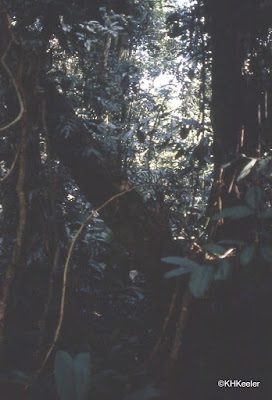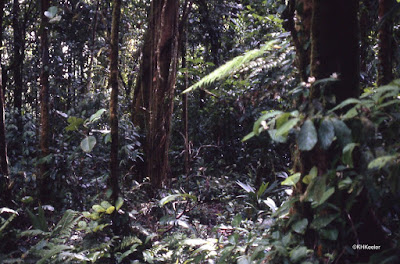forest.
I grew up in suburbia, it was love of plant ecology that drew me into strange activities like a week's trek in the rainforest.
In 1986 I was an Associate Professor of Biology at the University of Nebraska-Lincoln with research interests in ant-plant interactions. The Organization for Tropical Studies (link) had helped raise the money to protect watershed above their La Selva Field Station (link) in the Atlantic rainforest of Costa Rica (now part of Braulio Carillo National Park) and arranged for diverse scientists to come hike through it to see what was there. My teaching schedule made it impossible to go with the main group, but six of us, Dave Janos of the University of Miami, four students and I went a few weeks later.
 |
| Looking back at the forest from a gap |
Dave Janos and I did thesis research in Costa Rica at the same time, but in the intervening decade, Dave had worked continuously in Costa Rica while I had mostly been elsewhere. Dave was a very experienced rainforest ecologist and easily led the expedition.
The hike started at about 3000 m. (multiply by 3 for feet) and ended at La Selva, nearly at sea level. That was brilliant of Dave: the earlier group hiked up. I couldn't get there as early as he did, so I met the others at about 2500 m. elevation.
Memory is funny stuff: I found my notes and they say, a week before I left, "I'm not feeling very brave. To stay [home] would be FINE."
But of course I went.
I don't know what I was thinking: I way overpacked. So much that I worried about getting all that weight onto the international flight from Miami. Somehow it didn't register with me that on a backpack trip, you CARRY the things you take with you. I guess I was planning to leave lots of things with O.T.S.
Not to worry, my suitcase was lost in transit and only the (heavily-packed) backpack arrived. I made an emergency shopping trip in San Jose for essentials like boots and pants. I still had way too much gear and in fact did leave many items with O.T.S.
 |
| Log in the trail |
Martha Rosemeyer, Ph. D. student at U. California Santa Cruz, had gotten bad blisters in the previous days of hiking, so she was walking slowly. I was just slow. The other four started after we did on several days and always arrived well ahead of us. The good side of that is that they'd be setting up at the campsite when Martha and I arrived.
 |
| The old farm didn't look like much, but it was a snug, dry place to sleep |
 |
| Looking into the A-frame |
I took the picture below to show the mud. There's a log lying forming the entrance to the A-frame, and beyond that it was a sea of soft mud. I tried to step close, sit, swing my feet in, and get the boots off without bringing mud in. It was never fully successful. Outside A-frames and cabins, we were muddy to the knees nearly all the time.
 |
| Sea of mud outside the plastic-covered A-frame. |
I can't point to many dramatic highlights. Mostly we slogged through dim forests. My photographs do show that.
I don't remember seeing any mammals though we heard monkeys in the forest. Likewise, most of the birds were heard and not seen, but some were wonderful, bellbirds in particular.
 |
| snake on leaf |
I saw thousands plants, but the forest is so diverse I was happy to recognize what plant family they were in and delighted to guess the genus. I pressed plants, collected bits or made sketches to be able to identify them. In 1986 my camera was not digital and pictures had to be carefully chosen not to run out of film. There were some spectacular plants, though, like the insect-destroyed leaf below and the white seedling (no chlorophyll. Unable to synthesize its own food, it won't survive). Those things aren't unique to tropical rainforest of course.
 |
| insect-stripped leaf |
 |
| Seedling with no chlorophyll (white leaves) |
I took several photos of leaves with holes and layers of moss and fungi. In seasonal North American forests, leaves are shed and regrow every year. In the warmth and moisture of the tropical rainforest, leaves can--and do--last for years. Which allows all kinds of things to grow on them! Growing in the dim light of the forest floor, many plants grow slowly and have a lot of investment in each leaf. Consequently, like an old but driveable car, the plant keeps a battered leaf as long as it can.
 |
| old leaf with mosses and fungi growing on it |
Here and there, there were brightly colored insects! I don't have many photos of them: they generally ducked away when the camera was aimed at them.
 |
| Handsome insect with orange "knees" and feet. |
 |
| Lowland rainforest, lots of vines |
 |
| View of the forest at 1500 m |
Kathy Keeler, A Wandering Botanist
Join me on Facebook: https://www.facebook.com/AWanderingBotanist
More at awanderingbotanist.com



No comments:
Post a Comment